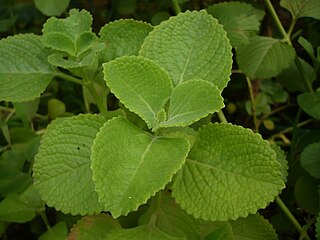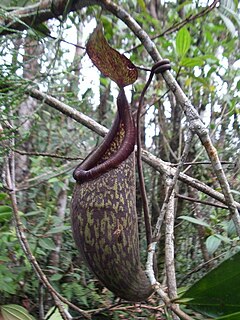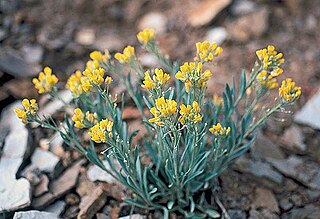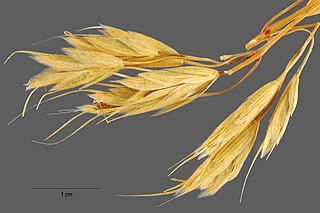
Coleus amboinicus, synonym Plectranthus amboinicus, is a semi-succulent perennial plant in the family Lamiaceae with a pungent oregano-like flavor and odor. The origin of Coleus amboinicus is unknown, but it may be native to Africa, and possibly India. Coleus amboinicus is widely cultivated and naturalized elsewhere in the tropics where it is used as a spice and ornamental plant. Common names in English include Indian borage, country borage, French thyme, Indian mint, Mexican mint, Cuban oregano, soup mint, Spanish thyme. The species epithet, amboinicus refers to Ambon Island, in Indonesia, where it was apparently encountered and described by João de Loureiro. Ambon is one of the Maluku Islands of Indonesia.

Pachypodium ambongense is a species of plant in the family Apocynaceae. It was first published as a species of the genus Pachypodium in 1924 by the botanist Henri Louis Poisson.
Pachypodium bicolor is a species of plant in the family Apocynaceae.

Pachypodium brevicaule is a species of plant that belongs to the family Apocynaceae.

Nepenthes rigidifolia is a critically endangered tropical pitcher plant endemic to Sumatra, where it grows at elevations of 1000–1600 m above sea level.

Bromus hordeaceus, the soft brome, is an annual or biennial species of grass in the true grass family (Poaceae). It is also known in North America as bull grass, soft cheat, and soft chess.

Bromus secalinus is a species of bromegrass known as rye brome. The specific epithet secalinus is Latin, meaning "rye-like". The fruits are hard, rounded glumes that appear superficially similar to the rye grain, which gives the brome its common and scientific name. The grass has a diploid number of 28.

Bromus madritensis is a species of brome grass known by the common name compact brome. The specific epithet madritensis refers to Madrid, Spain. It has a diploid number of 28.

Physaria is a genus of flowering plants in the family Brassicaceae. Many species are known generally as twinpods, bladderpods, or lesquerella. They are native to the Americas, with many species endemic to western North America. They are densely hairy annual and perennial herbs often growing prostrate or decumbent, along the ground in patches or clumps. They bear inflorescences of bright yellow flowers. The fruit is often notched deeply, dividing into twin sections, giving the genus its common name.

Bromus erectus, commonly known as erect brome, upright brome or meadow brome, is a dense, course, tufted perennial grass. It can grow to 120 centimetres (47 in). Like many brome grasses the plant is hairy. The specific epithet erectus is Latin, meaning "erect". The diploid number of the grass is 56.

Physaria obcordata is a rare species of flowering plant in the family Brassicaceae known by the common name Dudley Bluffs twinpod. It is similar in appearance to the more common Piceance twinpod, but can be distinguished by looking at the leaves through a hand lens. The Piceance twinpod, Physaria acutifolia has stellate hairs when viewed through a hand lens while Physaria ocordata has markings that look like a satellite dish, or a circle with a dot in the middle. It is endemic to Colorado, where it is found only in the Piceance Basin in Rio Blanco County. It is threatened by the loss and degradation of its habitat. It is a federally listed threatened species of the United States.

Physaria didymocarpa is a species of flowering plant in the mustard family known by the common name common twinpod. It is native to western North America, including British Columbia and Alberta in Canada and the northwestern United States.

Karomia speciosa is an African deciduous large shrub or bushy tree up to 7 m, and relocated to the family Lamiaceae from Verbenaceae. It is one of 9 species in the genus Karomia, a genus containing species previously classified in Holmskioldia, and is closely related to Clerodendrum. The only remaining species in the genus is Holmskioldia sanguinea, occurring in the foothills of the Himalayas.

Ipomoea oenotherae is a species of plant of the morning glory genus, Ipomoea, in the family Convolvulaceae. It derives its name from the resemblance it bears to plants in the genus Oenothera. Ipomoea oenotherae is a succulent and a cryptophyte.
Hypericum cuisinii is a perennial herb in the genus Hypericum, in the section Adenosepalum. The herb has pale yellow flowers and occurs in Greece and Turkey.

Bromus japonicus, the Japanese brome, is an annual brome grass native to Eurasia. The grass has a diploid number of 14.

Bromus squarrosus, the rough brome, is a brome grass native to Russia and Europe. The specific epithet squarrosus is Latin, meaning "with spreading tips". The grass has a diploid number of 14.

Hypericum denticulatum, the coppery St. John's Wort, is a perennial herb in the flowering plant family Hypericaceae. It is native to the Eastern United States. The species has two varieties, H. denticulatum var. recognitum and H. denticulatum var. acutifolium. The herb has a diploid number of 24 or 48.

Hypericum majus, the greater Canadian St. John's wort, is a perennial herb native to North America. The specific epithet majus means "larger". The plant has a diploid number of 16.

Passiflora bogotensis is a climbing plant native to Colombia, in the genus Passiflora. It can also be found in Venezuela.

















